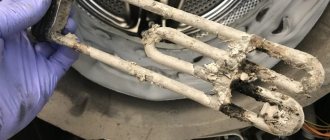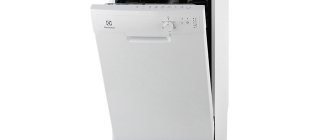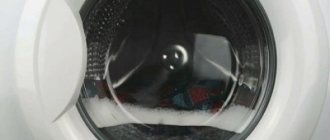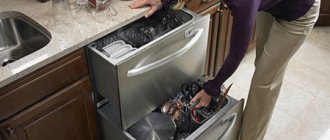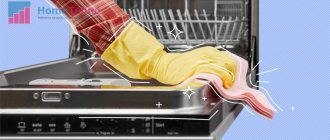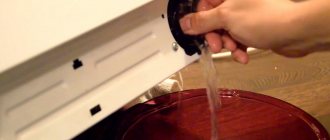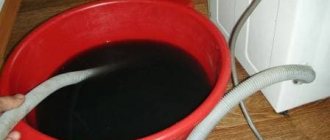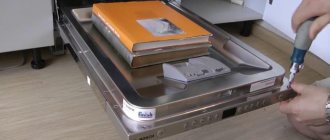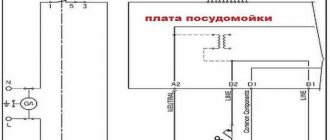There is always some working fluid left inside the dishwasher. A slightly open door helps evaporate excess moisture from the chamber. But in some situations it is necessary to drain the water completely from the machine.
- What is it for
- How to drain a working dishwasher
- How to drain a broken machine
- How to drain water if clogged
- What to do if it doesn’t drain
- Is there a difference in approach depending on the PMM brand?
- Catalog of dishwashers with reviews
How to turn on forced drain on a dishwasher
If during operation you notice that your dishwasher does not drain water. Don't worry ahead of time. There may be several reasons for this. Firstly, if there is water left at the bottom of the dishwasher. This is not always a sign that there are problems with the drain. You may have opened the dishwasher door too early.
In this case, the cycle is interrupted and the water remains at the bottom. Until the wash cycle is completed. Or there was a power outage and the washing program failed. In any case, first you need to understand how the dishwasher drain works and works.
Preventing the problem from recurring
In order to avoid recurrence of the problem, it is recommended to follow the following recommendations during operation:
- do not load dishes that are too dirty and have a lot of different food residues on them;
- keep the dishwasher drain filter clean;
- It is better to avoid connecting hot water to the dishwasher, since it is in hot water systems that most of the various contaminants are found.
You can find out why the dishwasher does not drain water and how to find and fix the problem in this section.
What are the reasons why water remains in the dishwasher?
To understand why there is water in the dishwasher. It is necessary to deal with issues such as. Was the dishwasher turned on? The wash cycle has just started or is about to end. Was there a power or water outage?
Did the dishwasher finish washing and leave water on the bottom or stop mid-run? If your dishwasher beeps and lights flash. Most likely, the problem was identified already at the stage of washing or starting the dishwasher. There may be several options. The main ones are below.
1. The dishwasher does not drain and remains idle
If after starting you find that the dishwasher does not make the characteristic washing sounds. And when we opened the door we discovered that there was water in the dishwasher. In such cases, the following often happens. The dishwasher fills with water as usual. But for some reason the circulation pump does not start. Washing does not occur. The water may heat up during the process.
In this case, you must cancel the program and close the door. If the water drains, but when restarted, the same thing happens. It is necessary to deal not with draining the water, but with the reason why the pump does not start
The dishwasher is clogged
A clogged dishwasher is not a rare occurrence. Failure to follow operating instructions often leads to food debris clogging the pipes. Shards of broken dishes can also clog your drain. But there is a possibility of damage to the drain pump. Both the dishwasher itself and the place where the drain hose is connected can become clogged. Usually this is an ordinary siphon. When connecting the dishwasher drain directly into the main pipe. The likelihood of clogging is noticeably reduced.
To remove the blockage, you need to clean the drain filter (the mesh under the sprinkler) and check the outlet into the sewer. If these procedures are not successful. Most likely you can’t do it without the help of a specialist. Indeed, in some cases. Even to clear a blockage. The dishwasher will require dismantling and partial disassembly.
Dishwasher pump is faulty
A dishwasher drain pump failure is also not uncommon. This is due to the fact that it is heavily loaded and is constantly in the water. For modern dishwashers 3 or more years old. The likelihood that the pump has failed is quite high. Testing it will require certain skills. Or replace it with a known good part. Which is suitable specifically for this dishwasher model.
The main sign of a malfunctioning drain pump can be considered the absence of sounds when the drain starts. Or interruptions in draining water, provided that there is no blockage in the dishwasher. It also cannot be ruled out that the pump starts only when a command to do so is received from the control unit. If the food doesn't arrive. Replacing the pump in a dishwasher will naturally not give any results.
Water at the bottom of the dishwasher
You will also be wondering why the water in the dishwasher is at the bottom. If you look under the filter, you can see what's underneath at the bottom. There is some amount of water. The norm (for different models) can be considered from a barely noticeable level to several centimeters. (5-7) Presence of water under the filter mesh. This is due to the fact that during draining, some of the water inevitably flows back out of the drain hose.
There is a check valve at the outlet of the drain pump. If it does not close tightly, or does not close at all. Water will form at the bottom. Leaking from the drain hose. In this case, it cannot be said that the dishwasher does not drain water. A small amount of its residue can be taken as normal. But if the water in the dishwasher is higher than the filter mesh. It's worth dealing with the problem.
Device
Hansa brand has its own characteristics, but basically the PMM scheme is as follows:
- control panel equipped with a screen;
- baskets for dishes (upper, lower);
- shelf for cups;
- device compartment;
- dispensers for detergent, rinse aid, salt;
- filters and sprayers inside the workplace;
- drain hose;
- inner tube;
- water supply hose.
Some models may differ in configuration and are supplemented with other elements or options.
How to turn it on
PMM Hansa is quite simple in its appeal; in order to turn on the dishwasher, you need:
- Plug in the power cord and check if the water supply valve is open.
- Add dishes, cleaning agent and close the door.
- Select a program, mode and press the appropriate button.
- Press “Start”.
Replacing the level sensor
In dishwashing equipment, the level sensor is called a pereostat; its function is to monitor the water level in the tank. Failure of this element may consist of physical wear, blockage, or electrical failure.
Before a complete replacement, you need to check the element for blockages. To do this, you need to unscrew 2 screws from the bottom of the machine, the fastening clamp, and blow out the tube. The electrical part can be diagnosed using a multimeter.
Drain system malfunctions
If, after washing dishes, the water does not completely leave the workplace and accumulates at the bottom, it means that there are problems in the operation of the drainage system. This is often due to stuck and accumulated debris; to eliminate the problem you need to do the following:
- Remove all plates and glasses from the machine and pull the lower rocker towards you, carefully unscrew the upper rocker.
- Check sprinklers for debris. If necessary, clean the injectors using a toothpick.
- Also inspect and clean the drain filter and the iron mesh at the bottom of the working area.
- If glasses or plates were chipped during the washing process, perhaps a splinter blocked the pump; Wearing gloves, you need to carry out a diagnosis.
How to check and start draining water in a dishwasher?
If the dishwasher did not drain the water. And you need to turn on forced drain. This procedure is performed differently depending on the brand and model. For dishwashers Bosch, Siemens, Neff. You need to reset the program and close the door. For older models. This program reset is performed by pressing two wash programs simultaneously. On the panel they are highlighted with a line and the inscription RESET.
For modern models. Press and hold the start button for a few seconds and close the door. If there is no blockage and the pump is working properly. The water should drain within 1.5 minutes. For dishwashers from other manufacturers, forced draining can be accomplished by canceling the program and starting another one. (draining water at the beginning of any cycle) Canceling a program is often done by holding down the program selection button. Or some other combination. (see instructions) In some dishwashers. To cancel the program. The dishwasher just needs to be turned off and on again.
How does a dishwasher drain work?
All the water that remains at the bottom of the dishwasher. When starting the drain pump. Pumping occurs. Water passes through the filter (if it is not clogged) then through a special hole at the bottom of the dishwasher. It is drawn into the drain pump itself and from the other side of the drain pump enters the pipe. There may be a check valve on the pipe. (Rubber plug that prevents water from flowing from the drain hose. Back into the dishwasher)
The drain hose may consist of several small hoses. But eventually the water ends up in the main hose. And it goes directly to the siphon. If food debris accumulates in any of these areas. A blockage occurs. The pump is running. But the water doesn't go away. Or it goes away very slowly.
Basic moments
How to turn on the car? Any instructions for Hansa household appliances are quite detailed and contain about 40 pages of text, diagrams, tables and photos, which are convenient to use both when connecting the device and installing it, and during its direct operation, where you can also see how the machine turns on.
On the first pages, the manufacturer writes a greeting and gratitude for choosing the brand, as well as a recommendation to carefully read the instructions for a specific model before using it.
Instruction sections:
- symbols used in the instructions and their interpretation;
- safety precautions for handling a Hans dishwasher;
- installation instructions;
- description of the main parts of the machine;
- recommendations for preparation for launch;
- description and selection of washing programs;
- cleaning and care tips;
- possible errors and ways to eliminate them;
- device data sheet.
Any Hans dishwasher is equipped with similar information. The instructions are also supplemented with practical advice from the manufacturer.
Important! You will find similar recommendations in the instructions for any equipment from different manufacturers. If you haven’t bought one yet, but are just planning to get a dishwasher, perhaps our reviews of the best models in the following categories will help you:
Let's look at the most important points in more detail.
What to do if the water does not come out of the dishwasher?
If you encounter this problem. You need to check your dishwasher filter. Also check the drain hose (connection to the siphon) Start draining the water in the dishwasher. If you have cleared the blockage. It will start and continue working as usual. Under no circumstances should you put liquid cleaners into your dishwasher to remove blockages in pipes.
First of all, they will not help 100%. Secondly, due to the alkali content. They can have a negative impact on the rubber parts of the dishwasher. And this is simply harmful to humans. If after all the manipulations, the water still does not go away. And you don't have the skills. It is necessary to contact specialists. Do-it-yourself dishwasher repair. It may simply not give positive results. But it also makes the problem worse.
We specialize in repairing dishwashers and such problems. They can be solved quite quickly and easily. Trust your equipment only to professionals.
The drain does not work: we solve the problem ourselves
If your machine stops draining water, pay attention to the hose. It is likely that it is simply in the wrong position (bent, pinched). Naturally, the machine simply has nowhere to drain the water. Straighten the hose carefully and plug in the dishwasher.
If the hose is in perfect condition, it is likely that the filter located at the bottom of the dishwasher is clogged. It gets clogged due to neglect of household appliances. You need to rinse the dishes before placing them inside the machine. But, more often than not, people are too lazy to do this. If this is exactly what happened, carefully clean the filter of debris. Wash under running water, preferably with a brush. And the machine is functioning normally again.
If the filter is in perfect order, we will examine the drainage system. The filter cells are not able to trap microscopic debris that somehow ends up in the machine along with the dishes. As a result, the drain hose may become clogged. To test this theory, disconnect it from the sewer and place it in a container prepared in advance. Then set a timer for the machine to drain. If water flows out with good pressure, it is necessary to clean the sewer. If the pressure is weak or the water does not flow at all, it means that debris has accumulated directly in the hose. Disconnect its other end from the machine and remove the blockage manually (with a stick or wire).
READ How to turn on the spin cycle on a washing machine
Another common reason for a non-functional drain is a clogged pump. You can try to fix this problem at home. Carefully unscrew the screws that secure the drain pump cover and remove all dirt. And then use a stick to check whether the impeller rotates easily, as in the video. But still, cleaning the pump requires a certain skill and skill. If you doubt your abilities, contact a master.
What to do if there is water left in the dishwasher filter.
How to drain water from a dishwasher: step-by-step instructions
Most often, it is necessary to forcefully drain the water from the dishwasher when some technical problems have arisen with it and the machine needs to be repaired. In this case, they try to drain the water completely and as carefully as possible. After all, during the repair process, the case will need to be turned over, and if the water is not drained, it may get on the power board or control module, which will provoke another breakdown. A short circuit on the power board can cause a current leak to the housing, which in turn poses a direct threat to the life and health of users.
In slightly more rare cases, people drain the water from the machine in order to preserve it for the winter. If the Bosch dishwasher is used only in the summer in an unheated room, then leaving it with water during the winter is dangerous. The frozen water inside will rupture the plastic pipes and the machine will have to be seriously repaired in the spring. In general, we have decided on the reasons for draining the water, now let's see how it is done.
Removing liquid from the working machine
We decided that it is only necessary to drain water from a working dishwasher if we decide to preserve the unit until spring. This is what we will proceed from. In order to remove all the water, you need to do the following.
- Select the water drainage program on the control panel.
- We wait until the machine completes it.
- We turn off the power to the dishwasher.
- We turn off the water supply and remove the hoses.
- Place rags on the floor near the right wall of the dishwasher.
- Unscrew the garbage filter and the lid of the salt tank.
- Carefully tilt the machine onto its right side. Some water may still drain out.
- We drag the dishwasher to a warm, well-ventilated place and open the door to let the machine dry inside.
After the above manipulations, the machine can be put away in a dry place. Let her stand quietly until the next season, nothing bad will happen to her now.
Removing liquid from a broken machine
If the dishwasher does not drain the water on its own, then the above method cannot be used. No, well, hypothetically, you can also tilt it on its side, but then not a single liter of water will pour out of the machine, which will certainly flood the power board. However, this measure does not guarantee that all the water will come out of the system, so we offer another solution. What to do?
- We turn off the power and disconnect the machine from water and sewerage.
- Open the door wide.
- We remove the lower basket and take out the garbage filter along with the mesh.
- We unscrew the plug with the ion exchanger tank, where salt is usually poured.
- We take a basin, an IV tube and a syringe. We connect one end of the tube to a syringe, and lower the other into the salt reservoir.
- The trick may not work the first time. Try again, after two or three attempts it will definitely work.
- We suck up the water with the syringe, remove the syringe from the end of the tube and lower this end into the basin. Water should flow by gravity from the salt reservoir into the basin.
- As soon as we manage to drain the water from the ion exchanger tank, we throw the end of the tube into the niche of the garbage filter and perform the same operation.
In this simple way, it is possible to remove almost a drop of water from the machine. Subsequent drying will complete the job and the very next day, you can safely carry out independent repairs or take the dishwasher to a service center.
Why doesn't the machine remove liquid?
Why does water remain in the Bosch dishwasher? Why does the machine stop draining water at one “wonderful” moment? This is usually due to either blockages or malfunctions of the elements responsible for draining water, most often the former. The fact is that many users neglect the basic rules of caring for their “home assistant”. This leads to food debris clogging the garbage filter and water stops circulating, remaining in the washing chamber. Of course, under these conditions, draining it turns out to be impossible.
This problem can be solved very simply. You need to roll up your sleeves, open the washing chamber door, unscrew and rinse the filter and the nearby mesh. After such “spring cleaning” the machine should work normally. It’s worse if the dishwasher does not remove water due to breakdown:
- pumps;
- circulation pump;
- water flow sensor;
- control module.
In this case, you need to immediately contact a specialist. A professional will quickly diagnose, clarify what is broken and repair your “home assistant”, leaving you with valuable recommendations along the way. You should not engage in self-repair, especially in cases where you have absolutely no experience in such matters.
So, removing water from the dishwasher turns out to be quite easy, the main thing is to know a few tricks, and the rest is a matter of technique. We hope our tips are really useful to you. Good luck!
What is it for
The need to remove liquid from the dishwasher may arise due to technical problems with the operation of the device. Before diagnostics and repairs, water is carefully drained so that it does not get on the control module and board. After all, any short circuit poses a threat to human health and life.
Before storing the dishwasher for the winter, water is also drained from the body, because it can harden and rupture the plastic pipes. We are talking about a situation where PMM is used at the dacha only in the summer.
How to drain your dishwasher for the winter
There are times when there is no need to constantly use such equipment, so it is worth mothballing it for a while. The most important thing is that there is no water left in it.
Draining the dishwasher
To completely remove all liquid, the following steps should be taken:
- find the water drain button;
- We wait for the program to start working;
- unplug the machine;
- turn off the water and remove the hoses;
- We spread rags around the car;
- unscrew the debris filter and the salt reservoir lid;
- We gradually tilt the machine onto the right side so that the water flows out completely;
- We move the dishwasher to another place where there is good air circulation. In this case, we leave the equipment with the door open so that it dries completely.
Why doesn't the device drain water on its own?
This situation is most often associated with malfunctions of any parts, but other reasons are also possible:
Deformation or kinking of the hose . Therefore, first you need to check whether it is pinched, sometimes you even need to disconnect the hose, align it, put it in place, and after that everything returns to normal.- Blockage. Occurs due to the fact that users do not adhere to operating instructions, and food debris gets inside the machine.
As a result, the filter becomes clogged and water stops draining in the usual way. In this case, you need to check the filters and the pump. The water is drained as described above.Then the filters are installed in place and the device is started. Usually after this the water drains normally, but if not, it means that some of the parts have failed.
- A breakdown of the pump or circulation pump is a malfunction in the operation of the devices that cause the movement of water.
- Failure of the H2O level sensor - in this case, the drain program does not start because it does not receive data from the pressure switch.
- Control module malfunction . In such cases, flashing helps; sometimes the unit has to be changed completely; only an experienced technician can determine this.
How to drain water from a dishwasher if it's broken
If a breakdown has been identified in the dishwasher, and the liquid has not drained on its own, then the above method of freeing it from water is unacceptable. As soon as the machine is tilted on its side, not just one liter of water will come out of it, but a significant stream that can flood the power board. Moreover, this does not provide a 100% guarantee of complete drainage of the liquid, so you should use another method:
- as in the previous case, it is worth disconnecting the equipment from the electrical network, as well as from water and sewerage;
- open the door completely;
- remove the lower basket and pull out the garbage filter along with the mesh;
- unscrew the plug from the ion exchanger tank, which is used to add salt;
- We begin to work with a tube, a dropper and a syringe. We connect the tube to the syringe at one end, and the other is lowered into the salt reservoir;
- Using a syringe, we suck in the liquid, remove it from the end of the tube and lower this end into the container. After these manipulations, water will drain from the salt tank on its own;
- As soon as the ion exchanger reservoir is completely emptied of liquid, we insert the same end into the niche from the emptied garbage filter and repeat this procedure again.
If everything is done correctly, the water will completely drain from the dishwasher. Afterwards, you should dry it thoroughly and start repairing it yourself, or take it to a service center.
You can also watch a video with a similar process of draining water:
Loading the machine
You can highlight the basic rules for loading products into the device, the observance of which will allow you to use it most effectively.
Upper basket
In this basket you can place fragile glassware, porcelain, as well as tea pairs, cups and glasses. You can also place cutlery between them. The dishes must be laid out so that they are not touched by the spray nozzles when the device is operating.
Important! It should be remembered that items placed in the upper basket should be lightly soiled.
Lower basket
More soiled items and deep dishes can be placed in this basket. For example: bowls, pans, baking sheets. As in the case of the top one, it is necessary to arrange objects in such a way that they do not touch them when the device is operating. And so that the water drains, it is better to place the products upside down.
Cutlery tray
If the machine is equipped with a special compartment, then cutlery should be placed in it. It is important to fold them with their handles up, place the longest utensils in the middle, and also make sure that they do not cling to each other.
You can find out more about the loading rules in the instructions for the Hansa dishwasher of your particular model. Our article on how to use a dishwasher correctly will also help you.
Let's take a closer look at the design of Hansa machines using the example of several models.
How to drain water from a dishwasher if the garbage filter is clogged
One possible reason for your dishwasher not draining properly is a clogged garbage filter. This system includes a mesh plate and cup that screw into the floor of the wash compartment. If dishes with food residues and other items such as toothpicks, napkins, fish and meat bones were placed in the machine, then the filter cells become clogged. To remove the blockage and clean the system, you need to remove all the components and wash them thoroughly under warm running water.
Basic steps to take:
- the cart is deleted;
- The filter glass is unscrewed;
- the mesh plate is removed;
- all this is cleaned with clean running water using a brush and detergent;
- Check that the spray arms are not clogged. If there is dirt, they also need to be cleaned well;
Cleaning the spray arm
Hansa ZIM 414 H
This built-in dishwasher can hold up to 9 standard place settings. The model has 4 programs and is protected from leaks.
Control Panel
Key control panel elements include:
- Washing program selection buttons.
- Program indicators.
- Indicators of lack of salt and rinse aid.
- Device on/off button and corresponding indicator.
Modes
The model is equipped with four programs:
- Intensive mode - allows you to wash very dirty dishes with dried particles. The cycle lasts 130 minutes.
- Short wash is a half-hour cycle that can handle lightly soiled dishes without starch.
- The ECO program will help wash lightly soiled dishes, but will cope with starch. The cycle duration is 160 minutes.
- 3 in 1 mode - a cycle suitable for daily washing of dishes with dried stains lasting 160 minutes.
Important! All programs additionally dry dishes, with the exception of the short cycle.
The first start-up sequence is similar to the ZIM 414 H model.
How to drain water from a dishwasher if other areas are clogged (for example, the pump)
If the water from the dishwasher is not draining well, the first thing to do is check and clean the filter. But if after these actions the water does not flow better, then the reason lies elsewhere. To troubleshoot, you need to check other areas of the drain system.
If, when you disconnect the hose, water flows out in a good flow, then the problem is closer to the entrance to the sewer system. Then the blockage is removed through regular cleaning.
But there are times when the drain pump becomes clogged. First of all, you should determine for yourself the best and easiest way to drain liquid from such equipment. The easiest way is by gravity, when the machine is tilted on its side. If this option is not suitable, the liquid is removed manually. Then the following actions are taken:
- the inlet hose is removed;
- the machine is placed on its side;
- the pan is unscrewed;
- the water level control sensor is removed;
- the pump is removed and the fasteners and contacts are released;
- the volute and impeller are cleaned;
- contacts are cleaned, resistance is checked;
- Check the pump valve for clogging, if any.
Cleaning the circulation pump
The dishwasher pump is one of the main elements. It provides forced circulation of water or cleaning solution through the internal lines of the device. This is done to save water, which changes only when you change the operating mode: pre-soaking, washing dishes or rinsing. During one stage of operation of the dishwasher, water circulates in a closed circuit.
Article on the topic: What plotters and digitizers allow you to do
If the filter is damaged or incorrectly installed, there is a possibility of solid particles entering the water circuit, which can lead to jamming of the circulation pump blades. If the quality of dishwashing deteriorates significantly, it can be assumed that the circulation pump is not performing its functions and needs maintenance, or rather, the fragment that is interfering with the normal rotation of the blades will have to be removed.
But not everything is so simple, since there are two types of design of the unit: with the ability to access the pump blades and without it. You can find out this point in the instructions for the dishwasher. If it describes the procedure for removing the protective covers, then the user has the opportunity to independently get to the pump impeller and fix the problem.
If the manufacturer directly prohibits the dismantling of protective covers and casings, then to eliminate the malfunction you will have to resort to the help of service specialists.
As for the general care of the water circulation system, it is important to understand that during operation, fatty deposits form on the walls of the water mains. They gradually reduce the throughput of the system, the pressure inside it increases, which does not have the best effect on the operation of the circulation pump and is fraught with various breakdowns: from rupture of the system tubes to failure of the pump.
To eliminate this factor, you need to make it a rule to clean your dishwasher regularly (once every 3-6 months, depending on the intensity of use) using specialized products. Only they, coupled with high temperature, are able to remove fatty deposits from the inside of the dishwasher.
Such products are produced in various forms: cleaning liquids, gels, tablets, etc. The logic of their use is the same. In accordance with the instructions for use, place the required amount of product into an empty dishwasher, set the operating mode to the highest possible temperature and start the washing cycle.
Article on the topic: Why the vacuum cleaner works jerkily
High temperature and aggressive chemicals dissolve and wash away all fat from the circulation system into the sewer.
Step-by-step instructions for draining water from different models
Draining water from a working dishwasher comes down to a number of specific steps.
To do this you need to do the following:
- Find the water drain button.
- Run the program.
- Unplug the unit.
- Shut off all water supplies and remove the hoses.
- Place rags near the machine to absorb moisture.
- Unscrew the filter and salt cap.
- Tilt the machine on its right side little by little to ensure that the water is completely removed from the inside.
- Place the unit in an area with plenty of drafts to effectively dry all components.
Only complete removal of water and subsequent drying can protect a machine that has been idle for a long time from rust, mold and a host of other negative manifestations.
It is worth noting that the described algorithm is only suitable for a running machine. If it is not able to drain the water on its own, it is not recommended to use it.
If there is a large volume of water when the device is tilted, the power board responsible for powering the device may be flooded. And this is a sure path to complete failure.
In this case, you should act a little differently:
- Disconnect the device from the network, water supply and sewerage.
- Surround the car with rags.
- Unscrew the filter and salt cap.
- Take a small flexible tube or hose (for example, from a dropper).
- Place one end of the tube in the water at the bottom of the machine.
- Connect the other end to the syringe and make a suction motion until water flows out.
- Place the other end of the tube in a container and wait until all the water has drained out.
These are general instructions that are suitable for most dishwasher models. However, it would be a good idea to consider some of the features of devices from different manufacturers.
Hansa
In operating condition, draining water is no different from the algorithm described above. The built-in system will automatically remove most of it, and the remaining residue can be easily drained when the unit is tilted.
If the machine is not working, then the only option is to remove water using a tube or absorbent sponges . In this case, you must first unscrew the filter and the mole hole cover.
Siemens
Siemens machines always drain water automatically. Running the drainage system will almost completely remove water from the interior, so even tilting is not always necessary.
In the event of a malfunction, the solution is to use tubes, rags and various containers for collecting water.
Gorenje
Draining water in Gorenje dishwashers is similar to the algorithm described above. There are practically no specific features . This applies to both working units and faulty ones.
Bosch
The process of removing water in a Bosch machine has some peculiarities.
First of all, when draining the water, it is enough to place a rag only under the right wall of the installation . It is on this side that you will need to tilt the device during the draining process.
For a faulty machine, you need to use a straw and a syringe, taking turns removing water from the filter niche, and then from the compartment under the salt tank. In this way, moisture can be completely removed from the interior without the risk of damaging the equipment.
Electrolux
Electrolux machines, like many other models, include filters and salt reservoirs located at the bottom.
Before draining, they must be disconnected from the general structure . This will open access to those places where water accumulates the most. This is especially important to observe when removing moisture from a non-working device.
Samsung
High-quality Samsung models rarely encounter the problem of lack of drainage. Under normal conditions, water is removed automatically and requires only minimal user intervention.
But you may have to tinker with a faulty machine, since it is unlikely that you will be able to remove the water without rags and special tubes. In this case, the algorithm of actions described above is completely valid.
When should the procedure be performed?
Most often, this need arises due to the lack of independent drainage of water.
This phenomenon does not mean that the device is completely broken , but it does indicate the presence of some kind of malfunction.
A small layer of water at the bottom of the machine can remain even in fully functional devices. This is worth considering, even if the manufacturer did not mention it in the instructions.
A small layer allows the gaskets located at the bottom to maintain their elasticity and performance. But if the water layer exceeds 1 cm, then there are already reasons for concern . In this case, you may need to drain it yourself.
Also, drainage may be required if there is a long absence of residents and equipment downtime. Even a small layer of water can cause a lot of problems. So it is better to remove all moisture in advance and leave the installation dry.
When to contact the service center
If the filter is clogged or the outlet hose is broken, everyone can fix the problem on their own. It is more difficult when the machine does not drain the water completely due to a breakdown of the control system or individual parts. In such cases, it is better to call a technician from the service center to repair the equipment.
Accumulation of debris in the drain pump and its breakdown
The accumulation of debris in the drain pump is one of the reasons for stagnant water, which is difficult to eliminate on your own. To check and remove the blockage, remove the pan and impeller. The part is cleaned of dirt and checked to see if it rotates freely. If the impeller does not rotate or does so with great effort, it is additionally cleaned from the inside.
After removing the impeller, you will have access to the pump. Next, the technician disconnects the wires coming from the part and connects them to a 220 V network. If the pump does not start, it is replaced with a new one.
Pressostat malfunction
The pressure switch is a water level sensor in a dishwasher. When it fails, water accumulates in the pan. The sensor cannot be easily reached, since it is located in the design of the equipment. To check the serviceability of the part, the technician uses a multimeter to test the electrical circuit. In the event of a breakdown, the pressure switch is replaced with a new one, since it is not repairable.
Attention ! If the warranty period has not passed, contact the service center. They will replace the pressure switch for free.
The pressure switch breaks not only due to blockage, but also due to oxidation on the contacts, defects in the tubes that reduce pressure, or wear during long-term use.
Software module failure
The most serious reason why there is water in the dishwasher is a malfunction of the software module. This is the “brain” of the equipment, responsible for all its work, including the program for forced drainage of water. Changing a module is very expensive. Therefore, if the equipment is under warranty, it is better to take it to the store. If it runs out, it is more profitable to buy a new dishwasher than to repair the electronic module. Its serviceability is checked only by a service center master using special devices and a program.
How to cope with the difficulties that arise?
We turn to professionals
If after all the above steps, your machine still refuses to drain the water, call a specialist. Most likely, a serious breakdown has occurred:
- The pump is broken. If this element “burns out” during operation, it must be replaced.
- Pressostat malfunction. This is a device that monitors the water pressure level inside operating equipment. It sends the received data to the software module and the machine, in turn, washes the dishes. If the necessary information is not received in a timely manner, the operating mode is disrupted. The broken part will need to be replaced.
- A software module has failed. He gives the necessary commands to the dishwasher: drain , add, heat water. A faulty module will not be able to perform its job correctly and fully. It needs to be reconfigured or replaced with a new one.
Repairing dishwashers is a complex and time-consuming process. You should not do it yourself or turn to self-taught masters. If you decide to save money, you will most likely end up with a pile of scrap metal. The service will give you a free diagnosis of your dishwasher and find the cause of the breakdown. And they will provide a guarantee for the repair work carried out. You need to save correctly.
Any washing household appliance constantly interacts with water, and dishwashers are no exception. Even if the appliance is turned off, there is still liquid left inside the system, so experts advise opening the door after each dishwashing to allow it to evaporate. It will also be useful to understand how to drain the water from the dishwasher.
Self-repair of Hansa dishwasher
How to drain the water
If the filter is clogged and water does not flow out of the machine completely, drain Hansa dishwasher yourself:
- Select the manual water drainage program on the control panel.
- Monitor the process.
- Disconnect the equipment.
- Close the water supply valve.
- Place rags under the device to absorb any remaining water from the work area.
- Unscrew the filter cover at the bottom of the housing and the salt compartment cover.
- Tilt the machine on one side to allow any remaining water to drain.
- Wash the inside of the device dry, leave the door open for 10-15 minutes so that it dries well inside to prevent an unpleasant, musty smell.
If the PMM is used only in the summer in an unheated room, then leaving it with water for the winter is dangerous. When water freezes inside, it ruptures the plastic pipes, requiring expensive repairs.
Causes of malfunction
All reasons that may be associated with drainage can be divided into two groups. The first group is associated with all kinds of blockages, and the second suggests a breakdown (malfunction) of some dishwasher unit. We list all the reasons for such a malfunction:
- The drain hose is kinked in some place, so the water does not physically leave the machine. It is enough to straighten it and try to turn on the machine again. Such a trivial problem rarely happens.
- the coarse filter is clogged. Do not neglect the simple rule - before loading, clean the dishes from food residues. Bones, napkins and other debris clog the filter holes, and water will not be able to leave the tank.
- clogged drain areas. Food that has passed through the filter can create a blockage in any part of the drain system, for example, in the pipes, drain hose or pump.
- the pump burned out;
- the pressure switch is faulty;
- The software module is broken.
In Bosch dishwashers from the SRV, SRS or SKF series, in some models the drain problem is detected only after the end of the program. In the middle of the cycle, the machine does not drain the water, but continues to wash dishes only in waste water. But when you open the door, you will see that there is water left in the tank. Some machine models may stop in the middle of the program, and the display will show the word “END” and an indicator in the form of a drawn faucet, which indicates an error during the program.
In Bosch dishwashers from the SMV, SPS or SKS series, if there is a display, fault code E24 will appear, informing about a problem with the drainage. If there is no display in the dishwasher, the lights will light up and a beep will sound and the machine will stop working.
How to use
The basic rules of use are as follows:
- The upper basket is designed to accommodate lightly soiled tableware made of fragile glass and porcelain. It is best to place glasses and cups here, and place cutlery horizontally between them.
- Plates and cups must be placed in such a way that they do not touch the filters and sprinklers.
- The lower basket is intended for very dirty plates, cups, for example, baking trays, bowls, salad bowls. The manufacturer recommends placing the plates upside down so that the entire surface gets water.
- Special trays (available in some models) are designed specifically to accommodate spoons and forks.
Indicators
Each Hans car has the following panel icons:
- Power supply - lights up when the equipment is plugged into an outlet.
- Half load indicator.
- Level indicator for cleaning and polishing solution (if it is on, you need to add more).
- Salt presence/absence sensor (if it lights up, you need to add salt).
Buttons
The following buttons are located on the PMM body:
- “On/Off” to stop or supply power;
- program selection button, cleaning cycle;
- half load button if less than 7 sets of dishes have accumulated;
- reboot and start.
Programs
As standard, Hansa appliances have the following dish cleaning modes:
- Standard sink for everyday use, used for dishes without dried dirt.
- Intensive mode, which makes it possible to clean even old dirt from dishes.
- Delicate mode - used for glasses and glasses without heavy soiling.
- The “hour” cycle is designed for lightly soiled dishes; there is no drying of the dishes.
- Pre-soaking - required for heavily soiled dishes, used before the main wash.
- The “eco-cleaning” mode is intended for cutlery made of crystal and porcelain to provide delicate washing and prevent chips and cracks.
It is necessary to turn on the machine only after all compartments have been loaded.
How to turn it on
Hansa PMMs are quite easy to use; in order to turn on the dishwasher, you need to:
- Plug in the power cord and check if the water supply valve is open.
- Add dishes, cleaning agent and close the door.
- Select a program, mode and press the appropriate button.
- Click "Start".
First start
The first start of the washing mode must be carried out according to the following recommendations:
- Load the dishes into the working plane of the device and, if possible, move them towards the rear wall.
- Add the tablet, powder and salt, pour in the rinse aid.
- After downloading and selecting the “Start” button, the machine will start working after 10 minutes.
If you urgently need to stop the machine and change the cleaning mode, you can do this before the device begins to flush detergent from the specialized compartments. To do this, you can open the door, and then the Hansa appliance will automatically stop operation. After this, switch the washing mode, close the door again, wait 10 minutes - the machine will start working.
